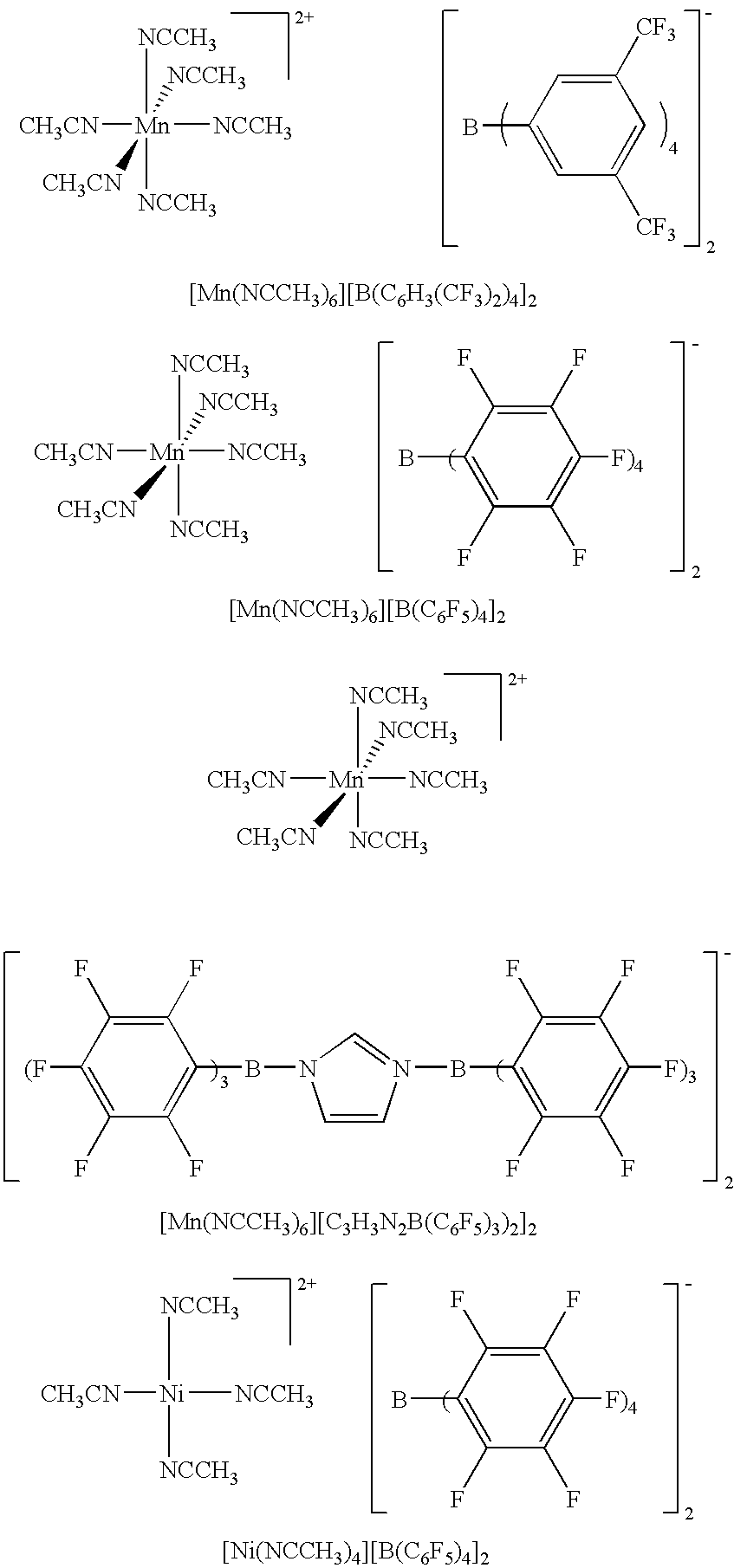Process for the production of highly reactive polyisobutenes
a polyisobutene, highly reactive technology, applied in the direction of hydrocarbons, chemistry apparatus and processes, organic chemistry, etc., can solve the problems of unnecessarily complicating the recycling of unreacted starting materials, less suitable for the mentioned intended application, and considerable cos
- Summary
- Abstract
- Description
- Claims
- Application Information
AI Technical Summary
Benefits of technology
Problems solved by technology
Method used
Image
Examples
example 1
[0039]12.80 mg of initiator [Mn(NCCH3)6][B(C6H3(CF3)2)4]2 (5.0·10−6 mol) were weighed out into a 38 ml autoclave under argon as protective gas and 20 ml of dry dichloromethane were added in a cooling bath at −40° C. 3 ml (1.988 g=0.0355 mol) of freshly condensed isobutene were added to the initiator solution. The isobutene was previously dried with a molecular sieve and potassium on activated carbon. The autoclaves were sealed and polymerization performed for 9 hours at 30° C. The solution remained colorless throughout the entire polymerization. After 9 hours, polymerization was terminated by addition of methanol and the polymer precipitated. A colorless, high viscosity polymer was obtained, which was dried to constant weight under a vacuum (50° C. / 0.1 mbar). 0.25 g of polymer (16.9% yield) with a molecular weight (Mn) of 9.0*103 Dalton (PDI=1.6) were obtained. The polymer can be stored in air and remains completely soluble.
example 2
[0040]12.43 mg of initiator [Mn(NCCH3)6][C3H3N2(B(C6F5)3)2]2 (5.0·10−6 mol) were weighed out into a 38 ml autoclave under argon as protective gas and 20 ml of dry dichloromethane were added in a cooling bath at −40° C. 3 ml (1.988 g=0.0355 mol) of freshly condensed isobutene were added to the initiator solution. The isobutene was previously dried with a molecular sieve and potassium on activated carbon. The autoclaves were sealed and polymerization performed for 16 hours at 30° C. and this solution too remained colorless throughout the entire polymerization. After the stated time, polymerization was terminated by addition of methanol and the polymer precipitated. A colorless, high viscosity polymer was obtained, which was dried to constant weight under a vacuum (50° C. / 0.1 mbar). 0.59 g of polymer (39% yield) were obtained with a molecular weight (Mn) of 6.4*103 Dalton (PDI=1.7). The polymer can be stored in air and remains completely soluble.
[0041]The content of terminal vinylidene...
example 3
[0042]24.86 mg of initiator [Mn(NCCH3)6][C3H3N2(B(C6F5)3)2]2 (1.0·10−5 mol) were weighed out into a 38 ml autoclave under argon as protective gas and 20 ml of dry dichloromethane were added in a cooling bath at −40° C. 3 ml (1.988 g=0.0355 mol) of freshly condensed isobutene were added to the initiator solution. The isobutene was previously dried with a molecular sieve and potassium on activated carbon. The autoclaves were sealed and polymerization performed for 16 hours at 30° C. and this solution too remained colorless throughout the entire polymerization. After the stated time, polymerization was terminated by addition of methanol and the polymer precipitated. A colorless, high viscosity polymer was obtained, which was dried to constant weight under a vacuum (50° C. / 0.1 mbar). 0.69 g of polymer (45% yield) were obtained with a molecular weight (Mn) of 5.5*103 Dalton (PDI=1.8). The polymer can be stored in air and remains completely soluble.
[0043]The content of terminal vinylidene...
PUM
| Property | Measurement | Unit |
|---|---|---|
| average molecular weight | aaaaa | aaaaa |
| temperature | aaaaa | aaaaa |
| temperature | aaaaa | aaaaa |
Abstract
Description
Claims
Application Information
 Login to View More
Login to View More - R&D
- Intellectual Property
- Life Sciences
- Materials
- Tech Scout
- Unparalleled Data Quality
- Higher Quality Content
- 60% Fewer Hallucinations
Browse by: Latest US Patents, China's latest patents, Technical Efficacy Thesaurus, Application Domain, Technology Topic, Popular Technical Reports.
© 2025 PatSnap. All rights reserved.Legal|Privacy policy|Modern Slavery Act Transparency Statement|Sitemap|About US| Contact US: help@patsnap.com

